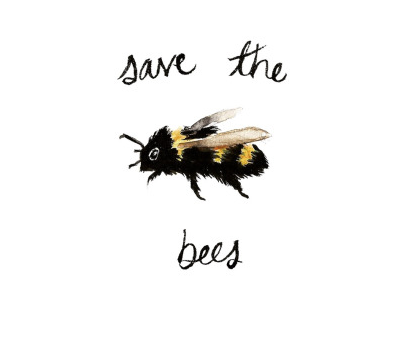Bee Not Afraid
Last week I was with my boyfriend on a grocery run. We were walking around this market just a mile away from our house that sells loads of local, organic produce among other ethically-made products. Being the honey lover he is, my boyfriend found the raw honey within minutes and was reading labels listing where it was from and the names of the farmers. At the time, I didn't even really know the difference between raw honey and what we tended to use at home, despite the fact that my uncle runs a honey farm. Thus, I was inspired and upon arriving back home, I dug into a bit of research. I mean, I had known bees were in danger but not really to what extent and I certainly hadn't realized how vital they were to today's society. Statistics about according to the Pesticide Action Network of North America, 1 out of every 3 bites of food we eat is pollinated by bees. Now, wiping out a third of our food sources is not exactly something we can just shrug off. Quickly, I found myself scouring the web for ways I could make a difference. The lists mostly seemed broad or focused on donating which, being a broke college student, wasn't really an option. Thus, I set out to create a list applicable to people like myself for what they can do. Here's what I've come up with.
Get Local, Get Raw
Keeping an eye out for locally grown honey, as well as fruit and veggies, as it will help give a bit more support to bee farmers. When you buy produce from them over big box farms you promote not only their ability to raise honey bees but also the organic farms generally use fewer pesticides and are more conscious about how it will affect bee populations and act accordingly. When buying honey, buy from a label that has a nearby location and states "untreated" on the container. Even better is going direct at a farmer's market and actually meeting the farmer you buy from. This offers them the best margins and gives you a chance to let them know how much their work is appreciated.
Plant Bee Friendly Herbs/Flowers
Who doesn't love the look of bright flowers sprawling their lawns or fresh herbs to throw into their favorite recipe? The ideal foraging spots for bees are going to be worth the energy of venturing to from their hive. Thus, a square yard or more is a good size to aim for with your bee-friendly plants. Some plants include sunflowers, poppies, buttercups geraniums, roses, and yellow hyssop. Options for those of you wanting to get some great meals out of your bee garden can plant things such as squash, strawberries, watermelons, pumpkins, catnip, sage, thyme, raspberries, and cucumbers. And for those wanting something a bit bigger for their yard, bees love blueberry bushes, button bush, Indigo, as well as Alder, Magnolia, Maple, Tulip, Sycamore, and Willow trees. With a range of sizes, this should give options from those with a nice acre in the suburbs to those with just a window sill to their name. You can go here to get an even more complete list of bees favorite plants.
Don't hate on weeds so much
Despite what you've been taught, weeds can be a good thing. Wildflowers are vital sources of food for native North American bees. Don't be afraid to let some of those infamous weeds thrive a bit in your ditch or in other parts of your yard. For those of you without yards, support local wildlife reserves in your area that let these kinds of wild flowers grow freely and provide a true safe haven for nearby bees. This support doesn’t have to monetary; it can be as simple as attending their events, which usually allows them more grants as well as can ignite more media coverage the more people attend.
Ditch the chemicals and pesticides
Yes, they can perfect your lawn but they wreak havoc on the ecosystem of your yard and beyond. When the pesticides are used near blossoming plants, especially while in bloom, it gets into the nectar and eventually brought back to the hive by an unsuspecting. From here it gets in the honey and thus into us. Additionally, cause harm to the bees themselves with symptoms such as disorientation, impaired immune system, disrupted independent generational cycles within the hive, and destroyed social communication abilities.
Water your plants and your Bees
Bees get thirsty too and a perfect addition to any bee garden is a water basin or bird bath, preferably with rocks or something in it that they can land on. It's simple and the bees will certainly appreciate it. One tidbit I'd like to add though is that standing water such as this can be breeding grounds for disease-carrying mosquitos. So to prevent them from swarming next spring, it would be a great habit to change the water in your basin weekly.
Spread the word
No matter how limited your resources, you can always share what you know with others. Sharing articles, telling friends, and even volunteering to spread the word with a local Bee Organization are all ways you can help teach others about how they too can save the bees.
It's no secret that the bees are in danger. From your twitter feed to the morning news, everyone seems to be warning that something has to be done to save the bees. Okay, of course, if a species is going extinct we can't sit by and do nothing but what can we do to actually make a difference? Equipped with the list above, you should be on your way to saving not only bees but the future of humanity.
Image by comradeandkin at tumblr.com
Image from beehabitat.com

















